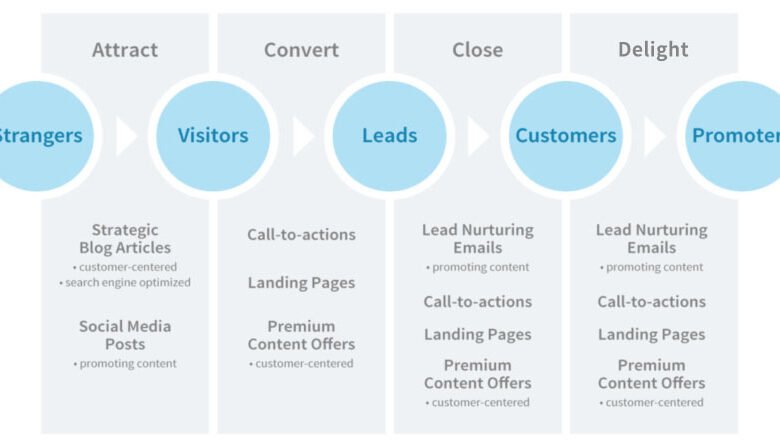The 4 Stages of Inbound Methodology: A Comprehensive Guide

Have you noticed how some businesses attract customers effortlessly, while others struggle to get noticed? The difference often lies in their marketing strategy. The inbound methodology is a proven approach that focuses on building relationships and providing value, helping businesses attract and retain customers more effectively.
This guide will break down the inbound methodology stages—Attract, Engage, Convert, and Delight. Whether you’re a small business owner or part of a marketing team, these stages can help you create stronger connections with your audience and drive growth.
What Is Inbound Methodology?
Inbound methodology is a marketing approach that emphasizes attracting customers by providing them with valuable and relevant information, rather than interrupting their experience with intrusive advertisements or unsolicited cold calls. This strategy revolves around creating content that resonates with the audience’s interests and needs, effectively guiding them through their buyer’s journey. By implementing inbound marketing techniques, businesses enable potential customers to find and engage with their brand on their own terms, particularly when they are ready to make a buying decision. This not only fosters a more authentic connection but also builds trust, ultimately leading to increased customer loyalty and satisfaction.
The inbound methodology stages are: Attract, Engage, Convert, and Delight. Let’s review each stage in detail.
1. Attract: Drawing in Your Audience
The first stage is about getting the attention of the right people. You want to bring relevant visitors to your website and create awareness about your brand.
Key Strategies:
- Create Quality Content: Share blog posts, videos, or infographics that provide helpful information for your target audience. People are more likely to visit your site when your content addresses their needs.
- Use Social Media: Platforms like Facebook, Instagram, and LinkedIn are great for sharing your content and reaching more people. Engage with your followers and use hashtags to improve visibility.
- Optimize for Search Engines: Implement basic SEO strategies to help your content rank higher on Google. Use keywords your audience is searching for and make your site user-friendly.
By offering valuable content and optimizing it for search engines and social media, you can attract visitors who are genuinely interested in what you offer.
2. Engage: Building Relationships
Once you’ve attracted visitors, the next step is to engage with them. Engagement is about building trust and making visitors feel valued.
Key Strategies:
- Personalized Communication: Use email marketing to send personalized messages based on users’ interests. Segmentation helps you target your messages, making them more relevant.
- Chatbots and Live Chats: Adding a chat feature to your website allows visitors to ask questions in real-time. Quick responses can improve their experience.
- Offer Lead Magnets: Provide free resources for contact information, like eBooks or guides. This helps build trust and allows you to gather leads for future outreach.
Engaging your audience effectively encourages them to see your business as a trusted source. This can make them more likely to consider your products or services in the future.
3. Convert: Turning Visitors into Leads
Once you’ve engaged visitors, it’s time to convert them into leads. This means encouraging them to take specific action, such as signing up for a newsletter or requesting a demo.
Key Strategies:
- Clear Calls to Action (CTAs): Every piece of content should have a clear CTA. Whether it’s downloading a resource or filling out a form, make sure it’s easy for visitors to take the next step.
- Landing Pages: Create focused landing pages that highlight a specific offer. These pages should be visually appealing and allow users to complete a simple form.
- Forms: Use short and straightforward forms to collect information from potential leads. The easier it is to fill out, the more likely visitors will submit.
Converting visitors into leads allows you to nurture them and move them closer to making a purchase.
4. Delight: Keeping Your Customers Happy
The final stage of inbound methodology focuses on delighting your customers so they become loyal to your brand. A satisfied customer is likelier to return and recommend your business to others.
Key Strategies:
- Excellent Customer Service: Providing helpful and responsive support is key to keeping customers happy. Address their needs quickly to maintain a strong relationship.
- Follow-Up: Send follow-up emails thanking your customers and asking for feedback after purchase. This shows that you value their input and are committed to improving.
- Loyalty Programs: Implement loyalty programs that reward customers for repeat business. Discounts, exclusive content, or early access to new products can encourage them to return.
Customers who are happy with your service are more likely to become repeat buyers and promote your brand through word of mouth.
Conclusion
Understanding and applying the four stages of inbound methodology—Attract, Engage, Convert, and Delight—can help your business create meaningful customer relationships. If you’re looking to improve your inbound marketing efforts, contact Responsify today. Their team can help you apply these inbound methodology stages effectively and guide you every step of the way.






